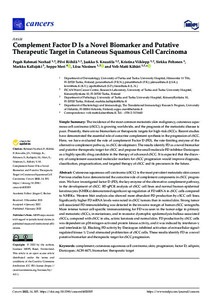Complement Factor D Is a Novel Biomarker and Putative Therapeutic Target in Cutaneous Squamous Cell Carcinoma
Nezhad Pegah Rahmati; Riihilä Pilvi; Knuutila Jaakko S.; Viiklepp Kristiina; Peltonen Sirkku; Kallajoki Markku; Meri Seppo; Nissinen Liisa; Kähäri Veli-Matti
https://urn.fi/URN:NBN:fi-fe2022081154596
Tiivistelmä
Cutaneous squamous cell carcinoma (cSCC) is the most prevalent metastatic skin cancer. Previous studies have demonstrated the autocrine role of complement components in cSCC progression. We have investigated factor D (FD), the key enzyme of the alternative complement pathway, in the development of cSCC. RT-qPCR analysis of cSCC cell lines and normal human epidermal keratinocytes (NHEKs) demonstrated significant up-regulation of FD mRNA in cSCC cells compared to NHEKs. Western blot analysis also showed more abundant FD production by cSCC cell lines. Significantly higher FD mRNA levels were noted in cSCC tumors than in normal skin. Strong tumor cell-associated FD immunolabeling was detected in the invasive margin of human cSCC xenografts. More intense tumor cell-specific immunostaining for FD was seen in the tumor edge in primary and metastatic cSCCs, in metastases, and in recessive dystrophic epidermolysis bullosa-associated cSCCs, compared with cSCC in situ, actinic keratosis and normal skin. FD production by cSCC cells was dependent on p38 mitogen-activated protein kinase activity, and it was induced by interferon-γ and interleukin-1β. Blocking FD activity by Danicopan inhibited activation of extracellular signal-regulated kinase 1/2 and attenuated proliferation of cSCC cells. These results identify FD as a novel putative biomarker and therapeutic target for cSCC progression.
Kokoelmat
- Rinnakkaistallenteet [27094]
